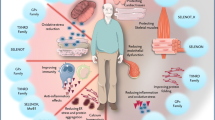Summary
□Background: Previous examinations have demonstrated decreased selenium levels in serum and full blood in patients with myocardial infarction.
□Patients and Method: 28 patients received a selenium treatment additional to the usual treatment of myocardial infarction. 19 patients with myocardial infarction with no supplementary selenium treatment served as a control group. Selenium levels in serum, full blood and urine were measured and the complications of the myocardial infarction documanted.
□Results: There was a significant increase of serum and full blood selenium and glutathione peroxidase levels under i. v. selenium therapy in the acute phase of myocardial infarction (first to third day). Left heart failure more rarely occured in the selenium group (20%) than in control patients (57%). Acute tachycardial cardiac rhythm disturbances such as ventricular extrasystoles and couplets diminished in both groups; ventricular extrasystoles decreased in the selenium group.
□Conclusions: Selen should be substituted in patients with acute myocardial infarction and decreased selen levels. It would be useful to carry out a prospective double-blind study.
Similar content being viewed by others
Literatur
Dawczynski, H., K. Winnefeld, E. Tennigkeit, D. Böwe: Die quantitative Bestimmung des Selens in Serum und Vollblut mit dem Gerätesystem Atom-Absorptions-Spektrophotometer AAS3/Hg/Hydridsystem HS. Applikationsformation des Kombinates VEB Carl Zeiss, Jena 5/1986.
Kalyanaraman, B., E. A. Konorev, J. Joseph, J. E. Baker: Radical generation and detection in myocardial injury. In: Rice-Evans, C. A., G. H. Burdon (eds.): Free radical damage and its control. Elsevier, Amsterdam 1994, 333–359.
Kretzschmar, M., R. Giese, W. Klinger: Rolle freier Radikale in der Pathogenese menschlicher Erkrankungen. Med. akt. 15 (1989), 530–532.
Köhler, H., H.-J. Peters, H.-J. Duck, K. Günther, H. Pankau: Herz-Kreislauferkrankungen und Spurenelemente. Zbl. Pharm. Pharmakother. Lab. Diagn. 121 (1982), 412–417.
Luoma, P. V., E. A. Sotaniemi, H. Korpela, J. Kumpulainen: Serum selenium, glutathione peroxidase activity and high-density lipoprotein cholesterol — effect of selenium supplementation. Res. Comm. Chem. Path. Pharmacol. 46 (1984), 469–472.
Oster, O., M. Drexler, J. Schenk, T. Meinertz, W. Kasper, C. J. Schuster, W. Prellwitz: The serum selenium concentration of patients with acute myocardial infarction. Ann. clin. Res. 18 (1986), 36–42.
Paglia, D. E., W. N. Valentine: Studies on the quantitative and quaitative characterization of erythrocyte glutathione peroxidase. J. Lab. clin. Med. 70 (1967), 158–169.
Peters, H. J., H. Köhler, H. J. Duck: Selen und seine klinisch-pathobiochemische Bedeutung bei Herzinfarkt. Wiss. Z. Karl-Marx-Univ.-Leipzig, Math.-nat.-wiss. Reihe 35, (1986), 195–204.
Ringdal, O., K.-J. Andersen, E. Svendensen, K. Julshamn: Trace elements and myocardial infarction, an autopsy study from Western Norway. Acta Pharmacol. Toxicol. 59 (1986), 358–360.
Salonen, J. T., G. Alfthan, J. K. Huttunen, J. Pikkarainen, P. Puska: Association between cardiovascular death and myocardial infarction and serum selenium in a matched-pair longitudinal study. Lancet 2 (1982), 175–179.
Salonen, J. T., R. Salonen, K. Seppänen, M. Kantola, M. Parviainen, G. Alfthan, P. H. Mäenpää, E. Taskinen, R. Rauramaa: Relationship of serum selenium and antioxidants to plasma lipoproteins, platelet aggregability and prevalent ischaemic heart disease in Eastern Finnish men. Atherosclerosis 70 (1988), 155–160.
Tiran, B.: Selen — ein essentielles Spurenelement. Wien. klin. Wschr. 109 (1997), 3–6.
Thiele, R., M. Schuffenhauer, H. Dawczynski, Y. Winnefeld: Selen-Konzentration im Serum und im Vollblut bei Patienten mit akutem Herzinfarkt und bei Patienten mit chronisch-ischämischer Herzerkrankung ohne Herzinfarkt. Intensivmed. Notfallmed. 27 (1990), 7–11.
Yagi, K.: Lipid peroxides in biology and medicine. Academic Press, New York 1982.
Author information
Authors and Affiliations
Rights and permissions
About this article
Cite this article
Thiele, R., Wagner, D., Gassel, M. et al. Selensubstitution bei akutem Myokrdinfarkt. Med Klin 92 (Suppl 3), 26–28 (1997). https://doi.org/10.1007/BF03041957
Issue Date:
DOI: https://doi.org/10.1007/BF03041957




